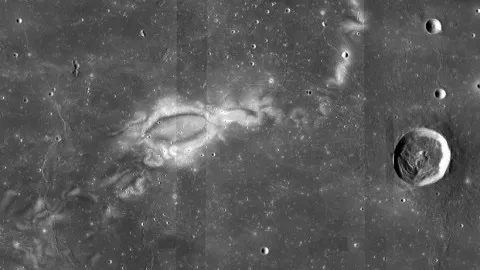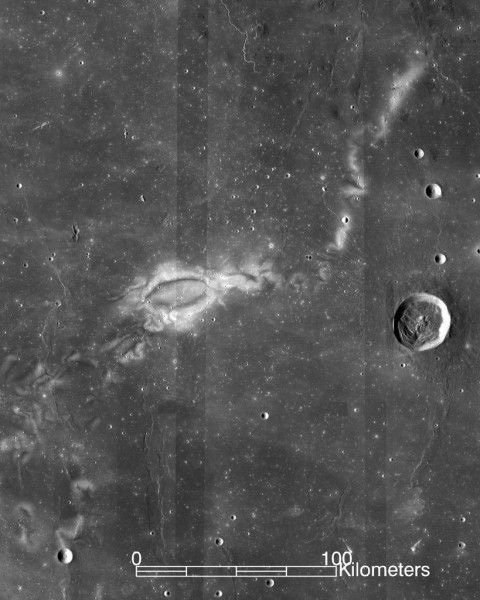12.11.2023
"Finding a relationship with topography in one swirl location could just be a fluke, but finding it in two vastly separate swirl regions is harder to ignore."

A mosaic of Lunar Reconnaissance Orbiter Camera images shows a light lunar swirl. (Image credit: NASA/Goddard Space Flight Center/Arizona State University.)
Swirls across the lunar surface are connected to changes in the moon's physical features after all, new observations from NASA’s Lunar Reconnaissance Orbiter (LRO) have revealed.
Lunar swirls are twisted-looking patches on the moon that shine brightly because they reflect high levels of sunlight. Because the amount of sunlight reflected back to space by a body is called its "albedo," these swirls are often referred to as being "high albedo." The swirls are marked by contrasting bright and dark imprints on the lunar surface, expressed as broad, bright loops separated by darker lanes.
Lunar swirls are known to occur in both the lunar mare — dark plains of basalt rock created by volcanism associated with ancient asteroid impacts on the far side of the moon — and bright lunar highlands.
Yet, the specific cause of these high-albedo lunar swirls has remained hotly debated. Determining the features' origin is considered key in understanding what processes have shaped the lunar surface, how particles move around on it, and even how the surfaces of planets and moons generally affect the space environment surrounding them.
"Lunar swirls have piqued scientists' interest since they were discovered, partly because
the scientific community doesn’t completely understand how they formed. There are many hypotheses about their formation process. Each hypothesis has observations that support it, but there are also other observations that contradict them," John Weirich, lead author of the new research and a senior scientist at the Planetary Science Institute, said in a statement. "The canonical interpretation of lunar swirls is that topography has no bearing on the location or shape of the swirl."
Recent research, he added, has finally begun to question this conclusion, finding that bright areas of the lunar swirl in Mare Ingenii — one of the few mares on the far side of the moon — have a lower elevation than the dark lanes running between them. The work of Weirich and his team further supports the connection between lunar swirls of the moon’s topography.
The duality of a lunar swirl

A mosaic of Lunar Reconnaissance Orbiter Camera images shows a light lunar swirl. (Image credit: NASA/Goddard Space Flight Center/Arizona State University.)
The team behind those previous findings Weirich mentioned reached their conclusion about the Mare Ingenii lunar swirl's varied elevations by generating and examining topographic data concerning lunar swirls in high resolutions.
Weirich and the team set about building on that by using similar methods.
In short, they found the same correlation as the previous researchers in lower bright areas and high-elevation dark lanes at one of the most visible lunar swirls, a 43-mile (70-kilometer) long feature called "Reiner Gamma."
"Finding a relationship with topography in one swirl location could just be a
fluke, but finding it in two vastly separate swirl regions is harder to ignore," Weirich said. "It is especially hard to ignore because Reiner Gamma is the archetypical lunar swirl."
Bright areas of the Mare Ingenii lunar swirl were found to be around 9.8 feet (3 meters) lower than the dark lanes, whereas the light parts of the Reiner Gamma were around 13 feet (4 meters) lower than those dark features.
"However, it is not as simple as the bright areas are uniformly lower than the dark areas. If that was the case, this relationship between topography and swirl would be easy to demonstrate by comparing an elevation map to a picture of the swirl," Weirich cautioned. "Instead, this relationship is only seen when we compare the average height of the bright areas and the average height of the dark areas."
While Wierich and colleagues gained their topography data from images taken by the Lunar Reconnaissance Orbiter Camera (LROC) they also utilized the probe's Stereophotoclinometry software suite that uses stereo images to determine the height of the lunar surface. Plus, they tapped into a machine learning program that was able to classify some bright areas of the swirl called "on-swirl units," as well as some dark lanes known as "off-swirl units." This multi-faceted approach also allowed the team to spot areas of transition between the two regions called "diffuse-swirl units."
"Since we don’t have a full understanding of how these swirls formed, we don’t completely understand the story they can tell us about the moon," Wierich concluded. "Forming them could involve a combination of well-understood processes interacting together or a currently unknown process. Unusual objects or phenomena are sometimes the key to obtaining deeper knowledge, and for this reason, lunar swirls are very intriguing.
"And the fact that they look really cool."
The team’s research was published on Thursday (Nov. 9) in the Planetary Science Journal.
Quelle: SC

